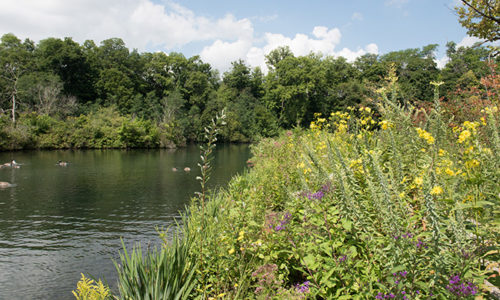Gérance environnementale
Gérance environnementale
La commission des parcs du Niagara est l’une des organisations environnementale originales de l’ontario. Depuis sa fondation en 1885, Niagara Parks on rempli un mendat qui comprend la préservation de l’habitat naturel le long du couloir de la rivière Niagara, du lac Érié au lac Ontario.
Aujourd’hui , le mandat de gérance environnementale de Niagara Parks est au centre de sa mission pendant que la commission travaille à la protection, à la conservation et à la promotion de l’héritage culturel et naturel du vouloir de la rivière Niagara. Ce mandat comprend maintenant la poursuite de pratiques de conservation novatrices ainsi que la création d’une organisation qui est elle-même durable dans ses politiques, ses plans et ses activités.
Préservation du littoral de la rivière Niagara



Efforts pour soutenir les espèces menacées



Gestion durable des terres



Partenariat stratégique
Partenariat avec le centre de recherche sur la durabilité environnementale de l’Université Brock
En Avril 2018, Niagara Parks et le centre de recherche sur la durabilité environnementale de l’Université de Brock ont officialisé un partenariat pour collaborer à des projects mutuellement bénéfiques axés sur l’intendance environnementale. Ce partenariat, connu sous le nom de l’excellence en matière d’intendance de l’environnementale, d’informer et d’améliorer la pratique et d’accroîte la capacité de Niagara Parks et de son personnel à faire des décision fondées sur des preuves.
Niagara Parks collaborent régulièrement avec les groupes et organisme suivants:Ministry of Tourism, Culture and Sport; Ministry of Natural Resources and Forestry; Environment Canada; Ontario Power Generation; Parks Canada; Forests Ontario; NGO’s – Canadian Wildlife Federation, Land Care Niagara, Niagara Restoration Council; Nature Clubs – e.g. Niagara Falls Nature Club; Friends of Niagara Glen; and Local Municipalities.
Document Library
-
Restoring Riparian Zones of the Niagara River ProjectNom de fichierNiagara Parks PIC - Sept 2018 - Riparian Restoration.pdfDernière modificationFeb 19, 2019
Over the next two years, this project will aim to create, restore, and expand up to 2 kilometres of vegetated shoreline buffers along the Niagara River through the removal of non-native species, where required, and the planting of a diversity of native plant species. Also, where possible, woody debris will be anchored at select locations within the river to soften the shoreline and provide suitable fish refuge and nursery habitat. In collaboration with Niagara College’s Ecosystem Restoration Program, priority areas for shoreline vegetation restoration have been identified for initial implementation.
Download pdf -
Service Rd 29 & 30 Rear Properties Restoration PlanNom de fichierService Rd 29 & 30 Restoration.pdfDernière modificationNov 30, 2018
Due to Emerald Ash Borer infestation, a significant number of ash trees have been removed from Niagara Parks land directly behind the residences along service road 29 and 30. Property encroachment activities have also impacted the ecological integrity of this woodlot. Niagara Parks has developed a restoration planting plan behind these properties to control invasive species, as well as improve and support the ecosystem health. The plant materials are selected to provide a buffer of low-growing, ornamental, bird-attracting and berry producing shrubs that are fast growing native species to inhibit establishment of buckthorn and other invasive species. Additionally, trees of the same species as existing vegetation are used to infill or replace ash trees. In wet areas, wet-tolerant species for the wetland planting and butterfly/pollinator-attracting wildflowers for the meadow planting are proposed. The planting is scheduled for the Spring 2019.
Download pdf -
Emerald Ash BorerNom de fichierNiagara Parks PIC - Sept 2018 - EAB.pdfDernière modificationSep 28, 2018
The Emerald Ash Borer (EAB) is a non-native invasive insect that has killed millions of ash trees in southwestern Ontario and in the United States, and a confirmed infestation in Niagara Parks was confirmed in 2012. Infested ash trees die off within two to five years, posing a major economic and environmental threat to urban and forested areas.
Download pdf
Qui Écoute?
Faites connaître votre opinion et veuillez soumettre vos commentaires à l’équipe de projet développant les stratégies de gérance environnementale de Niagara Parks.

Ellen Savoia
Senior Manager, Environmental Planning

Corey Burant
Project Manager, Forest Health Parks, Planning & Properties
